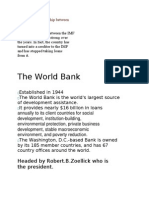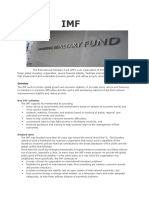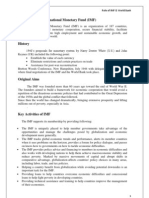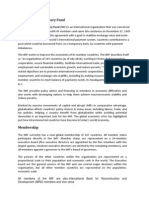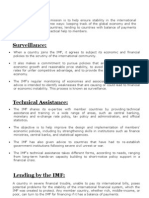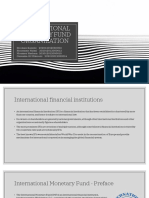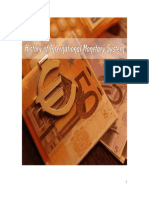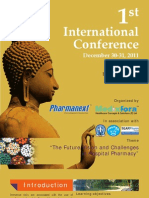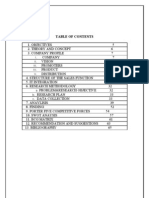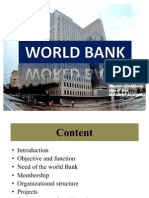Globalization: Key IMF Activities
Globalization: Key IMF Activities
Uploaded by
Jack DanialCopyright:
Available Formats
Globalization: Key IMF Activities
Globalization: Key IMF Activities
Uploaded by
Jack DanialOriginal Description:
Original Title
Copyright
Available Formats
Share this document
Did you find this document useful?
Is this content inappropriate?
Copyright:
Available Formats
Globalization: Key IMF Activities
Globalization: Key IMF Activities
Uploaded by
Jack DanialCopyright:
Available Formats
With its near-global membership of 188 countries, the IMF is uniquely placed to help member governments take advantage
of the opportunitiesand manage the challengesposed by globalization and economic development more generally. The IMF tracks global economic trends and performance, alerts its member countries when it sees problems on the horizon, provides a forum for policy dialogue, and passes on know-how to governments on how to tackle economic difficulties. The IMF provides policy advice and financing to members in economic difficulties and also works with developing nations to help them achieve macroeconomic stability and reduce poverty. Marked by massive movements of capital and abrupt shifts in comparative advantage,globalization affects countries' policy choices in many areas, including labor, trade, and tax policies. Helping a country benefit from globalization while avoiding potential downsides is an important task for the IMF. The global economic crisis has highlighted just how interconnected countries have become in todays world economy. Key IMF activities The IMF supports its membership by providing policy advice to governments and central banks based on analysis of economic trends and cross-country experiences; research, statistics, forecasts, and analysis based on tracking of global, regional, and individual economies and markets; loans to help countries overcome economic difficulties; concessional loans to help fight poverty in developing countries; and technical assistance and training to help countries improve the management of their economies. Original aims The IMF was founded more than 60 years ago toward the end of World War II (see History). The founders aimed to build a framework for economic cooperation that would avoid a repetition of the disastrous economic policies that had contributed to the Great Depression of the 1930s and the global conflict that followed. Since then the world has changed dramatically, bringing extensive prosperity and lifting millions out of poverty, especially in Asia. In many ways the IMF's main purposeto provide the global public good of financial stabilityis the same today as it was when the organization was established. More specifically, the IMF continues to provide a forum for cooperation on international monetary problems facilitate the growth of international trade, thus promoting job creation, economic growth, and poverty reduction; promote exchange rate stability and an open system of international payments; and lend countries foreign exchange when needed, on a temporary basis and under adequate safeguards, to help them address balance of payments problems. An adapting IMF The IMF has evolved along with the global economy throughout its 65-year history, allowing the organization to retain its central role within the international financial architecture As the world economy struggles to restore growth and jobs after the worst crisis since the Great Depression, the IMF has emerged as a very different institution. During the crisis, it mobilized on many fronts to support its member countries. It increased its lending, used its cross-country experience to advise on policy solutions, supported global policy coordination, and reformed the way it makes decisions. The result is an institution that is more in tune with the needs of its 188 member countries. Stepping up crisis lending. The IMF responded quickly to the global economic crisis, with lending commitments reaching a record level of more than US$250 billion in 2010. This
figure includes a sharp increase in concessional lending (thats to say, subsidized lending at rates below those being charged by the market) to the worlds poorest nations. Greater lending flexibility. The IMF has overhauled its lending framework to make it better suited to countries individual needs. It is also working with other regional institutions to create a broader financial safety net, which could help prevent new crises. Providing analysis and advice. The IMFs monitoring, forecasts, and policy advice, informed by a global perspective and by experience from previous crises, have been in high demand and have been used by the G-20. Drawing lessons from the crisis. The IMF is contributing to the ongoing effort to draw lessons from the crisis for policy, regulation, and reform of the global financial architecture. Historic reform of governance.The IMFs member countries also agreed to a significant increase in the voice of dynamic emerging and developing economies in the decision making of the institution, while preserving the voice of the low-income members.
The IMFs main goal is to ensure the stability of the international monetary and financial system. It helps resolve crises, and works with its member countries to promote growth and alleviate poverty. It has three main tools at its disposal to carry out its mandate: surveillance, technical assistance and training, and lending. These functions are underpinned by the IMFs research and statistics. Surveillance The IMF promotes economic stability and global growth by encouraging countries to adopt sound economic and financial policies. To do this, it regularly monitors global, regional, and national economic developments. It also seeks to assess the impact of the policies of individual countries on other economies. This process of monitoring and discussing countries economic and financial policies is known as bilateral surveillance. On a regular basisusually once each yearthe IMF conducts in depth appraisals of each member countrys economic situation. It discusses with the countrys authorities the policies that are most conducive to a stable and prosperous economy, drawing on experience across its membership. Member countries may agree to publish the IMFs assessment of their economies, with the vast majority of countries opting to do so. The IMF also carries out extensive analysis of global and regional economic trends, known as multilateral surveillance. Its key outputs are three semiannual publications, the World Economic Outlook, the Global Financial Stability Report, and the Fiscal Monitor. The IMF also publishes a series of regional economic outlooks. The IMF recently agreed on a series of actions to enhance multilateral, financial, and bilateral surveillance, including to better integrate the three; improve our understanding of spillovers and the assessment of emerging and potential risks; and strengthen IMF policy advice. For more information on how the IMF monitors economies, go to Surveillance in the Our Worksection. Technical assistance and training IMF offers technical assistance and training to help member countries strengthen their capacity to design and implement effective policies. Technical assistance is offered in several areas, including fiscal policy, monetary and exchange rate policies, banking and financial system supervision and regulation, and statistics. The IMF provides technical assistance and training mainly in four areas: monetary and financial policies (monetary policy instruments, banking system supervision and restructuring, foreign management and operations, clearing settlement systems for payments, and structural development of central banks);
fiscal policy and management (tax and customs policies and administration, budget formulation, expenditure management, design of social safety nets, and management of domestic and foreign debt); compilation, management, dissemination, and improvement of statistical data; and economic and financial legislation. For more on technical assistance, go to Technical Assistance in the Our Work section. Lending IMF financing provides member countries the breathing room they need to correct balance of payments problems. A policy program supported by financing is designed by the national authorities in close cooperation with the IMF. Continued financial support isconditional on the effective implementation of this program. In the most recent reforms, IMF lending instruments were improved further to provideflexible crisis prevention tools to a broad range of members with sound fundamentals, policies, and institutional policy frameworks. In low-income countries, the IMF has doubled loan access limits and is boosting its lending to the worlds poorer countries, with loans at a concessional interest rate. For more on different types of IMF lending, go to Lending in the Our Work section. Research and data Supporting all three of these activities is the IMFs economic and financial research andstatistics. In recent years, the IMF has applied both its surveillance and technical assistance work to the development of standards and codes of good practice in its areas of responsibility, and to the strengthening of financial sectors. These are part of the IMFs continuing efforts to strengthen national and global financial systems and improve its ability to prevent and resolve crises.
You might also like
- Global CorrelationsDocument47 pagesGlobal CorrelationspkanakaNo ratings yet
- International OrganizationsDocument12 pagesInternational Organizationsapi-282906646100% (1)
- The Great DepressionDocument3 pagesThe Great DepressionMyles PetersonNo ratings yet
- Allied Bank (M) SDN BHD V Yau Jiok Hua - (20Document14 pagesAllied Bank (M) SDN BHD V Yau Jiok Hua - (20Huishien QuayNo ratings yet
- VERSIONSDocument27 pagesVERSIONSHamza Sandli100% (1)
- About The IMF: Bretton Woods System and ImfDocument8 pagesAbout The IMF: Bretton Woods System and ImfNilesh BhosaleNo ratings yet
- Imf and Loan ConditionalityDocument17 pagesImf and Loan ConditionalityAgat100% (1)
- Introduction of Imf: 1.1 MeaningDocument58 pagesIntroduction of Imf: 1.1 MeaningRiSHI KeSH GawaINo ratings yet
- IMF and INDIa FileDocument23 pagesIMF and INDIa FilehocordinatoreNo ratings yet
- Itl Unit IDocument4 pagesItl Unit IShrabani KarNo ratings yet
- International InsititutionDocument23 pagesInternational InsititutionNelsonMoseMNo ratings yet
- Imf Pograms:Who Is Chosen & What Are The Efffects?: Paper ReviewDocument6 pagesImf Pograms:Who Is Chosen & What Are The Efffects?: Paper ReviewMadiha KhanNo ratings yet
- Objection To TWC CH 11 PlanDocument33 pagesObjection To TWC CH 11 PlanTHROnlineNo ratings yet
- Role Ngo For Human RightDocument4 pagesRole Ngo For Human RightAditya Intan Bodiman LukmanNo ratings yet
- The Current Relationship Between Imf N World BankDocument13 pagesThe Current Relationship Between Imf N World Bankmishrasneha76439No ratings yet
- Final Participation Report of AFMIDPAC From REEL A7186Document242 pagesFinal Participation Report of AFMIDPAC From REEL A7186Downfall10% (1)
- International Monetary FundDocument12 pagesInternational Monetary FundPia SottoNo ratings yet
- Notes On International Business Finance Portion - 2 Example On Balance of Payment (BOP) : Example 1Document9 pagesNotes On International Business Finance Portion - 2 Example On Balance of Payment (BOP) : Example 1Md Tabish RazaNo ratings yet
- Of T!) e GS, Tatts: Mnit2bDocument34 pagesOf T!) e GS, Tatts: Mnit2bNorbert PiechowiakNo ratings yet
- Iran-Contra: President Reagan's MotivesDocument5 pagesIran-Contra: President Reagan's MotivesElena LazarNo ratings yet
- Franklin Hills Country ClubDocument10 pagesFranklin Hills Country Clubprince noble james beyNo ratings yet
- Community Medicine True FalseDocument14 pagesCommunity Medicine True FalseDr-Jahanzaib GondalNo ratings yet
- CREW: Department of Defense: Central Intelligence Agency: Regarding NSA Reporting Requirements: Cover LetterDocument3 pagesCREW: Department of Defense: Central Intelligence Agency: Regarding NSA Reporting Requirements: Cover LetterCREWNo ratings yet
- General Maurice Challe, Protégé of CIA Director Allen Dulles, Plot Against de Gaulle51 - 22-23Document2 pagesGeneral Maurice Challe, Protégé of CIA Director Allen Dulles, Plot Against de Gaulle51 - 22-23alfalimaechoxrayNo ratings yet
- International Monetary Fund: Nikul G Moradiya (10M66) Kartik Y Joshi (10F57) Jasmin R Kheni (10F52)Document37 pagesInternational Monetary Fund: Nikul G Moradiya (10M66) Kartik Y Joshi (10F57) Jasmin R Kheni (10F52)Jayesh Vasava100% (1)
- About The IMF: GlobalizationDocument56 pagesAbout The IMF: GlobalizationPranjal SrivastavaNo ratings yet
- Acknowledgement: Mrs. Rajam Rajagopalan For Her Exemplary Guidance, Monitoring and ConstantDocument41 pagesAcknowledgement: Mrs. Rajam Rajagopalan For Her Exemplary Guidance, Monitoring and ConstantVineeth MudaliyarNo ratings yet
- Key IMF ActivitiesDocument4 pagesKey IMF ActivitiesDwani SangviNo ratings yet
- Report:The International Monetary Fund (IMF) : Tatarlî Anastasia, 102RIDocument6 pagesReport:The International Monetary Fund (IMF) : Tatarlî Anastasia, 102RIAnastasia TatarlîNo ratings yet
- Key IMF ActivitiesDocument10 pagesKey IMF Activitiesfalvi99No ratings yet
- The Multimedia Content On This Page Cannot Be Printed.Document14 pagesThe Multimedia Content On This Page Cannot Be Printed.tarak1401884898No ratings yet
- What We Do: Key IMF Activities Original Aims Adapting To ChangeDocument8 pagesWhat We Do: Key IMF Activities Original Aims Adapting To Changewaseem ahmadNo ratings yet
- About The IMF2Document10 pagesAbout The IMF2Subhobrata MukherjeeNo ratings yet
- Imf Presentation DataDocument13 pagesImf Presentation DataAli SyedNo ratings yet
- International Finance Management Assignment: Topic-International Monetary FundDocument19 pagesInternational Finance Management Assignment: Topic-International Monetary Fundniks1190No ratings yet
- Imf ProjectDocument7 pagesImf ProjectDeepali MestryNo ratings yet
- Role of IMFDocument20 pagesRole of IMFSwati Sharma100% (1)
- Assignment On Working of ImfDocument10 pagesAssignment On Working of ImfKartikay KharbandaNo ratings yet
- SurveillanceDocument10 pagesSurveillanceBianca BiaNo ratings yet
- IMF and World BankDocument26 pagesIMF and World BankNinatte QuadrosNo ratings yet
- IMFDocument4 pagesIMFRitwiz RishabhNo ratings yet
- International Monetary Fund SomaliDocument5 pagesInternational Monetary Fund SomalikhayyumNo ratings yet
- 3 NassDocument3 pages3 NassshawnguroNo ratings yet
- Banking & Insurance Law (Samiksha)Document11 pagesBanking & Insurance Law (Samiksha)Samiksha SakshiNo ratings yet
- Surveillance: Role of IMFDocument2 pagesSurveillance: Role of IMFbalakrishnanvishnuNo ratings yet
- Contribution of IMF in Global TradeDocument48 pagesContribution of IMF in Global TradeNainaNo ratings yet
- The IMF (International Monetary Fund) and Its Implications in ArgentinaDocument8 pagesThe IMF (International Monetary Fund) and Its Implications in ArgentinaDora S DejeuNo ratings yet
- Economics: Keshav Mohindru XTH Pink 12Document10 pagesEconomics: Keshav Mohindru XTH Pink 12nishamohindruNo ratings yet
- Group 3 Presented by JeroDocument18 pagesGroup 3 Presented by JerojerovargasNo ratings yet
- Our WorkDocument2 pagesOur WorkSuraj BaugNo ratings yet
- International Monetary Fund in Globalization: International Organization Bretton Woods ConferenceDocument43 pagesInternational Monetary Fund in Globalization: International Organization Bretton Woods ConferenceYogita BathijaNo ratings yet
- Financial Management 9Document10 pagesFinancial Management 9Nicole Bianca Asuncion CorralesNo ratings yet
- Shruti IMF 2263Document19 pagesShruti IMF 2263Shruti ChahalNo ratings yet
- International Monetary FundDocument23 pagesInternational Monetary FundOussama MimoNo ratings yet
- IMF by NIKHIL KANGODocument6 pagesIMF by NIKHIL KANGONikhil KangoNo ratings yet
- International Financial and Economic Organizations (GEED 151) By: Mr. ANT VEYSEL (Group 1)Document31 pagesInternational Financial and Economic Organizations (GEED 151) By: Mr. ANT VEYSEL (Group 1)Anonymous GVWIlk3ZNo ratings yet
- Safeguarding Stability IMFDocument12 pagesSafeguarding Stability IMFvikasjaiswalbhuNo ratings yet
- Sistem Kewangan Antarabangsa: Halaman 115-128 Bab 9Document14 pagesSistem Kewangan Antarabangsa: Halaman 115-128 Bab 9bennameerNo ratings yet
- IMF, World Bank and PakistanDocument29 pagesIMF, World Bank and Pakistansaad_sheikh_1100% (1)
- What Are Saps?: (Leftwitch, 1996)Document10 pagesWhat Are Saps?: (Leftwitch, 1996)Keshav DattaNo ratings yet
- Imf ProjectDocument17 pagesImf ProjectkitkomalNo ratings yet
- Why The IMF Was Created and How It WorksDocument14 pagesWhy The IMF Was Created and How It Worksnaqash sonuNo ratings yet
- 1.1 ImfDocument7 pages1.1 Imfkanishka singhNo ratings yet
- Project 1Document57 pagesProject 1RubikaNo ratings yet
- Quiz 2Document3 pagesQuiz 272101335No ratings yet
- Real Estate Mortgage CasesDocument14 pagesReal Estate Mortgage CasesMatthew WittNo ratings yet
- Term Sheet Sanover Basha 1Document2 pagesTerm Sheet Sanover Basha 1mdarshadskh8171No ratings yet
- BrochureDocument6 pagesBrochureMargos MosgarNo ratings yet
- Delfin Domingo DadisDocument4 pagesDelfin Domingo DadisTrisha AmorantoNo ratings yet
- Standard Offer Letter For Regular CA CustomersDocument3 pagesStandard Offer Letter For Regular CA CustomersmaheshvkrishnaNo ratings yet
- Ht2509i001115665Document3 pagesHt2509i001115665Ishu BishtNo ratings yet
- SR - DEN Co NGP Acting For and On Behalf of The President of India Invites E-Tenders Against Tender No DRMWNGP-21-2019 ClosingDocument5 pagesSR - DEN Co NGP Acting For and On Behalf of The President of India Invites E-Tenders Against Tender No DRMWNGP-21-2019 ClosingRahul AgarwalNo ratings yet
- Carlos Hilado Memorial State College - Fortune Towne Campus Final Exam - 1 SEM, SY 2016 - 2017 Bs in Information Systems 2CDocument1 pageCarlos Hilado Memorial State College - Fortune Towne Campus Final Exam - 1 SEM, SY 2016 - 2017 Bs in Information Systems 2CAprille JunioNo ratings yet
- MAP Myanmar Diagnostic Full Report Final PDFDocument237 pagesMAP Myanmar Diagnostic Full Report Final PDFliftfundNo ratings yet
- Draft Interview QA - UpdatedDocument6 pagesDraft Interview QA - Updatedrevola28No ratings yet
- Consumer Credit June 2019Document3 pagesConsumer Credit June 2019Natasya JescorinNo ratings yet
- Donations To Jehovah's Witnesses: ZambiaDocument7 pagesDonations To Jehovah's Witnesses: Zambianasty9052gNo ratings yet
- N4 Introductory Accounting November 2019Document7 pagesN4 Introductory Accounting November 2019Nompilo mncwangoNo ratings yet
- Barings CollapseDocument3 pagesBarings CollapseGohYueQuan100% (1)
- Commercial Bank FinalDocument92 pagesCommercial Bank FinalakshayNo ratings yet
- Frenzel v. Catito, G.R. No. 143958, July 11, 2003, 406 SCRA 55Document14 pagesFrenzel v. Catito, G.R. No. 143958, July 11, 2003, 406 SCRA 55TENsai1986No ratings yet
- Truth in Lending ActDocument3 pagesTruth in Lending ActammeNo ratings yet
- How David Sokol Lost His WayDocument3 pagesHow David Sokol Lost His WayBisto MasiloNo ratings yet
- Brach Closure XXXXXXX3504 57403Document1 pageBrach Closure XXXXXXX3504 57403Mukesh Kumar SoniNo ratings yet
- Literature Review On Credit UnionsDocument9 pagesLiterature Review On Credit Unionsea2167ra100% (1)
- IFAS EFAS SFAS and Strategic Solution of VCBDocument9 pagesIFAS EFAS SFAS and Strategic Solution of VCBHồng KhánhNo ratings yet
- Project IciciDocument72 pagesProject IciciundefinedmohitNo ratings yet
- Wa0033.Document5 pagesWa0033.HarshanNo ratings yet
- Bus 516 ProjectDocument23 pagesBus 516 ProjectDorpon IftekharNo ratings yet
- Final World BankDocument25 pagesFinal World BankKumar PraveenNo ratings yet














